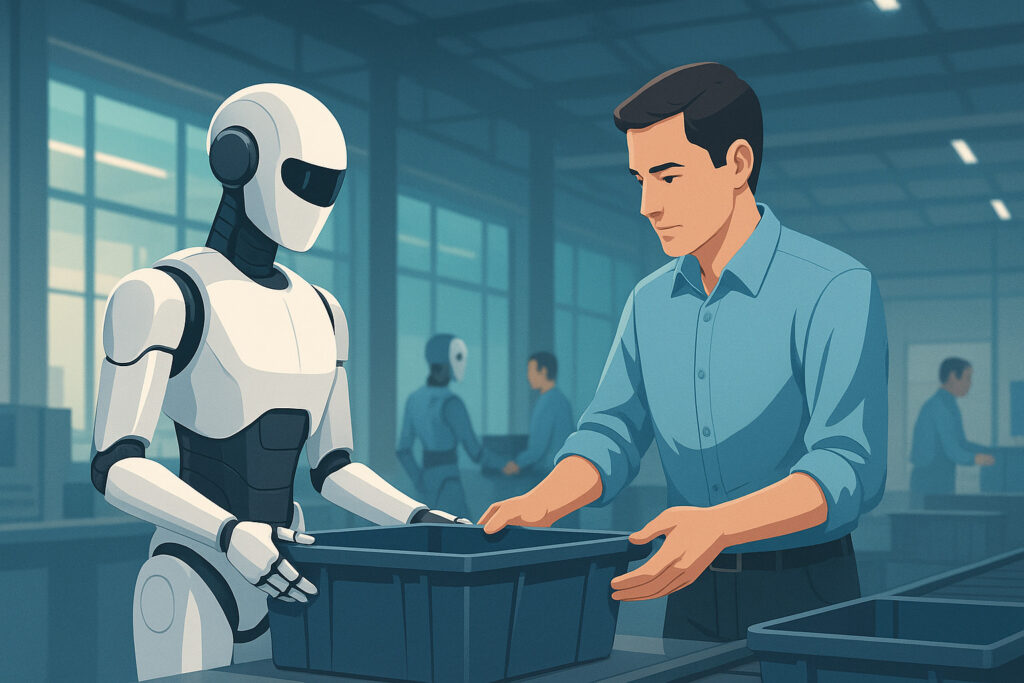🦾 What Is Physical AI? — The Dawn of Intelligent Machines That Move —

When people think of AI, they often picture systems like ChatGPT — tools that understand language and respond intelligently.
But a new wave of innovation is taking shape: “Physical AI” — artificial intelligence that not only thinks, but also moves.
By combining sensors, robotics, and intelligent algorithms, Physical AI systems can perceive their surroundings, make decisions, and take action in the real world.
In other words, AI is growing a body.
💡 What Makes Physical AI Different
- Autonomous perception → decision → action cycles
- Fusion of robotics (body) + AI (intelligence) + sensors (senses)
- Rapid adoption in key sectors such as logistics, mobility, and healthcare across the U.S.
🚚 Key Real-World Applications
1) Logistics and Warehousing: Amazon Robotics
At Amazon’s fulfillment centers, AI-powered robots like Proteus navigate safely among human workers, transporting shelves and optimizing routes in real time.
The result is a highly efficient and safer workspace where humans and robots collaborate seamlessly.
2) Autonomous Mobility: Zoox (Amazon Subsidiary)
Zoox is building a fully driverless vehicle — no steering wheel, no pedals.
In pilot operations around Las Vegas, its AI systems handle everything from perception to passenger interaction.
It’s a glimpse into a future where mobility itself becomes an intelligent agent.
3) Humanoid Robotics: Figure 03 & Tesla Optimus
- Figure AI is developing the Figure 03, a third-generation humanoid robot capable of understanding verbal instructions and performing complex, everyday tasks in homes, warehouses, and retail settings.
- Tesla’s Optimus continues iterative testing for factory automation and simple repetitive tasks. While production timelines have evolved, it represents a steady move toward real-world deployment.
👉 Humanoids have a key advantage: they can operate in existing human environments without major infrastructure changes — lowering adoption barriers.
4) Healthcare and Hospital Operations: Moxi by Diligent Robotics
Developed by Austin-based Diligent Robotics, Moxi is designed for hospitals to autonomously transport samples, supplies, and medical materials within wards.
By intelligently navigating crowded hallways, Moxi helps reduce nurses’ walking distance and waiting time — easing workloads and improving efficiency in healthcare settings.
🌍 Why Physical AI Matters Now
- Severe labor shortages in logistics, manufacturing, and healthcare
- The need for safety and consistency in high-risk environments
- Advances in generative AI that enable smarter perception and planning
In the U.S., Physical AI is becoming less about replacing humans and more about collaborating with them — reshaping how work itself is done.
🔮 What’s Next
- Broader rollout in controlled environments such as warehouses, hospitals, and factories
- AI-to-AI learning loops that continuously optimize movement and decision-making
- Expansion into homes and offices, bringing intelligent automation into daily life
We are entering an era where AI doesn’t just compute — it acts, moves, and works alongside people.
✨ Key Takeaways
- Physical AI = AI that operates in the physical world
- U.S. companies are leading innovation in logistics, mobility, healthcare, and humanoid robotics
The next decade will be defined by human-AI collaboration